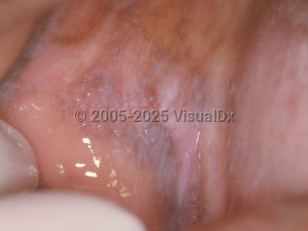Oral lichen planus - Oral Mucosal Lesion
Alerts and Notices
Important News & Links
Synopsis

Patients may have few to no symptoms if they have the classic or reticular form of oral LP. Erosive and ulcerative oral LP lesions are associated with increased sensitivity to acidic, spicy, and crunchy foods as well as pain.
Some patients present with erosive / erythematous and ulcerative lesions on the gingiva, representing the clinical entity known as desquamative gingivitis. Brushing often causes pain and bleeding, so oral hygiene is generally poor, and patients with desquamative gingivitis are more likely to have the vulvovaginal-gingival or peno-gingival syndrome with genital involvement in addition to oral involvement. Overall, vulvovaginal involvement is found in around a quarter of women and penile involvement in 5% of men with oral LP.
Up to approximately 40% of patients have cutaneous LP in addition to oral LP. While patients with esophageal lichen planus often have oral LP, the reverse is not always true.
Medications such as antihypertensive agents, some NSAIDs, sulfasalazine, and carbamazepine are associated with the development of cutaneous and oral LP. Statins have been implicated in cutaneous LP. Oral LP is also associated with hepatitis C. Lesions may also appear locally as a result of hypersensitivity to a contactant (such as amalgam and composite restorations, gold, and cinnamic aldehyde compounds).
Lesions are usually present for months and years and will relapse and remit. There is potential for malignant transformation to well-differentiated squamous cell carcinoma, with 1%-5% of individuals with oral LP reported with malignant transformation.
Related topics: lichenoid drug eruption, lichen planopilaris
Codes
L43.9 – Lichen planus, unspecified
SNOMEDCT:
235049008 – Oral lichen planus
Look For
Subscription Required
Diagnostic Pearls
Subscription Required
Differential Diagnosis & Pitfalls

Subscription Required
Best Tests
Subscription Required
Management Pearls
Subscription Required
Therapy
Subscription Required
Drug Reaction Data
Subscription Required
References
Subscription Required
Last Updated:10/02/2025

